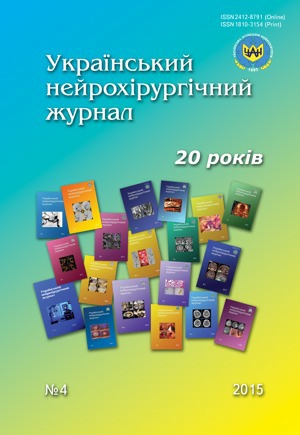A case of surgical treatment of a penetrating blunt diametric gunshot brain wound
DOI:
https://doi.org/10.25305/unj.55965Keywords:
penetrating brain injury, diametric injury, diametric wound, surgical treatmentAbstract
A metal fragment passed through the left frontal bone causing a penetrating fracture and further through the right and left hemispheres. The metal fragment hit the contralateral inner plate of the frontal bone and rebounded into the brain. Brain injury was also caused by secondary wounding objects such as bone debris that penetrated into the opposite hemisphere 6.7–7.2 cm deep from the inner bone plate at the entrance wound.
The patient underwent an extended initial surgical brain wound debridement, which included entrance wound management, bilateral craniotomy, subdural hematoma and cerebral detritus removal, radical multiple bone debris and metal fragment removal, and tidal brain wound drainage.
The neurosurgery was performed to the full extent, which promptly aided the patient’s recovery and helped prevent postoperative complications. New data were discovered about how bone debris spread in the brain in case of a gunshot injury.
References
1. Mogila VV, Siomkin KV. [Surgical extraction peculiarities of the foreign bodies in weapon wounds of the head in the peace time]. Ukrainian Neurosurgical Journal. 2005;(3):97-100. Russian.
2. Mogila VV, Syomkin KV. [Gunshot wounds to the head in the peace time]. Ukrainian Neurosurgical Journal. 2003;(2):50-53. Russian.
3. Chaplyk V, Oliynyk P., editors. Nevidkladna viyskova khirurhiya [Emergency War Surgery]. Lviv: Nautilus; 2015. Ukrainian.
4. Clinical Practice Guidelines [Internet]. Available at: http://usaisr.amedd.army.mil/clinical_practice_guidelines.html
5. Polishchuk NE, Starcha VI. Ognestrel'nyye raneniya golovy [Gunshot wounds of the head]. Kiev: Ton; 1996. Russian.
6. Pedachenko EG, Danchin OG, Polishchuk ME, Tsymbaliuk VI. Orhanizatsiya nadannya spetsializovanoyi neyrokhirurhichnoyi dopomohy u viyskovyy chas (z•hidno oboronnoyi viyskovoyi doktryny): metod. vkazivky [Organization of specialized neurosurgical care in wartime (according to defensive military doctrine): Guidelines]. Kiev; 2014. Ukrainian.
7. Knuth T, Letarte PB, Ling G, Moores LE, Rhee P. Guidelines for field management of combat-related head trauma. New York: Brain Trauma Foundation; 2005.
8. Konovalov AN, Lihterman LB, Potapoov AA., editors. Cherepno-mozgovaya travma: klinicheskoye rukovodstvo [Traumatic brain injury: Clinical Guidelines]. Moscow: Antidor; 2001;2. Russian.
9. Gaydar BV. Ognestrelnyye raneniya cherepa i golovnogo mozga [Gunshot wounds of the skull and brain]. In: Abstract Book of Conference "Contemporary gunshot injury"; 1998; St. Peterspurg, Russia. p.15-6. Russian.
10. Gaydar BV, Shulev YuA, Verkhovskiy AI, Parfenov VE. Boyevyye povrezhdeniya tsentralnoy nervnoy sistemy. [Battle damage to the central nervous system]. Klinicheskaya meditsina i patofiziologiya. 1998;1:55-65. Russian.
11. Popov VS. Infektsionnyye oslozhneniya ognestrelnykh ran cherepa i ikh lecheniye. [Infectious complications of gunshot wounds of the skull and treatment]. In: Abstract Book of All-Army Conference “Experience of Soviet Medicine in Afghanistan” October 26-27, 1992; Moscow, Russia. p.42-3. Russian.
12. Teplyashin VF, Pykhonin SN, Zagorodniy FF, Suri GM. Prilivno-otlivnoye drenirovaniye cherepno-mozgovykh ran v sisteme profilaktiki posleoperatsionnykh oslozhneniy. [Tidal drainage of traumatic brain injuries in the prevention of postoperative complications]. In: Abstract Book of the Conference “Actual Issues of Military Medicine», devoted to the 10th anniversary of the April Revolution; 1988; Kabul. p.139-140. Russian.
Downloads
Published
How to Cite
Issue
Section
License
Copyright (c) 2015 Andriy Sirko

This work is licensed under a Creative Commons Attribution 4.0 International License.
Ukrainian Neurosurgical Journal abides by the CREATIVE COMMONS copyright rights and permissions for open access journals.
Authors, who are published in this Journal, agree to the following conditions:
1. The authors reserve the right to authorship of the work and pass the first publication right of this work to the Journal under the terms of Creative Commons Attribution License, which allows others to freely distribute the published research with the obligatory reference to the authors of the original work and the first publication of the work in this Journal.
2. The authors have the right to conclude separate supplement agreements that relate to non-exclusive work distribution in the form of which it has been published by the Journal (for example, to upload the work to the online storage of the Journal or publish it as part of a monograph), provided that the reference to the first publication of the work in this Journal is included.









